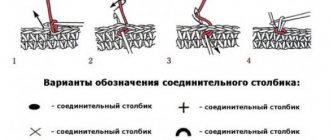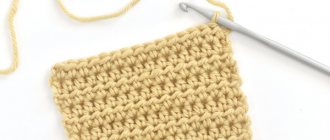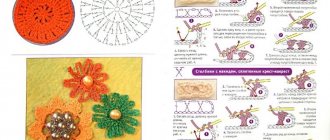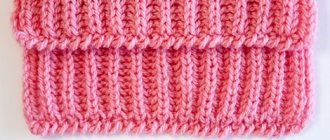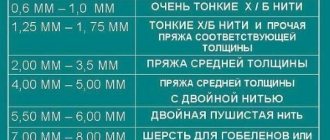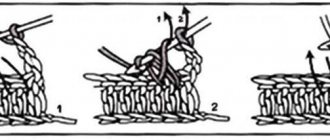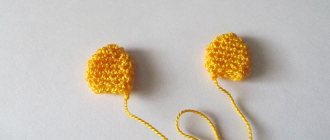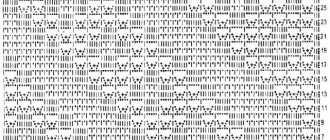The stitch is a fundamental element of crochet. The path to creating even the simplest products lies through mastering it. Each of several types of columns is useful for any craftswoman to study and practice. Basic rules
There are three popular techniques for performing the element:
- for the right, far loop;
- for the left, near loop;
- for two slices of the bottom loop;
The initial row is made behind the back wall of the air loop, and for subsequent rows two walls of the elements of the previous row are used. The hook runs from the front of the product. This technique is considered basic and is used in most cases. If the instructions imply a different approach, this is usually described there.
The number of columns in rows should be the same. There should be as many of them in the first row of straight fabric as in the last. To make decorative elements similar to drawings, it is permissible to change their number.
Half column
The half-column stitch is used to create circular knitting patterns and to fasten parts of the product. Introducing it into the structure of the canvas gives it rigidity and does not allow it to stretch too much.
Step by step instructions:
- Cast on 20-25 chain stitches.
- Then the tool is threaded through the nearest loop. The thread is wound and threaded. As a result, there should be two in one loop.
- The resulting loop is threaded into the next one.
- Do this until the row ends.
- Then it’s time to turn the composition over.
- The result will be the desired trapezoidal half-column, tapering towards the end.
Single crochet
Anyone who wants to master crocheting should learn this type of element. This is the most common part used for most products.
Instructions:
- Cast on about twenty chain stitches, add 1 lifting stitch.
- Make a loop by inserting your hook into the second loop from it. Now there should be two of them.
- Throw the thread over and pull it through the resulting loops, there are two of them on the hook.
- Do the same until the row ends.
- To make a lifting loop, the product must be turned over.
- Then you need to make about seven rows of columns without throwing a thread.
- Here you can experiment with the drawing. By creating five columns alternately for the right and left parts of the lower loops, you can evaluate and select the pattern most suitable for the job.
Double crochet
A very common type of column. Being easy to create, the element is twice as long as the knitted one without draping. The best friend of beginners and people limited in time.
- Cast on 20 chain stitches plus two lifting stitches.
- The thread is thrown over the tool and inserted into the third loop from the bottom. Next, you need to stretch the thread so that you get three loops in one.
- Next you need to throw on the thread and knit 2 loops next to the tool.
- Throw on again and knit the remaining two loops.
- Repeat until the end of the row.
- In total you need to make eight rows.
Double crochet stitch
This post is ideal for making filigree products with a large mesh due to the large loop height. A characteristic feature of the resulting canvas is that it looks the same both from the front and from the inside. In addition, it is softer than most others and knits faster.
- Knit a cast-on chain of the required length.
- Wrap the yarn around the hook twice and make a loop.
- Now you need to pull it through the air loop of the cast-on chain. There should be four of them on the instrument.
- Yarn over. Pull through a loop, leaving three on the hook.
- Repeat. Now there should be two loops left.
- Yarn over again and pull through a loop.
- The column is ready. The four stitches skipped at the beginning are considered the 1st stitch of the new cast-on row.
- Now, in the same way, one such column is knitted from each stitch of the cast-on row.
- The very first stitch of the new row is knitted from the top of the 2nd stitch of the previous row.
- Next, in the new row, the columns are knitted along one of the columns of the previous one.
- Finally, the last stitch of the new row is knitted from the top of the lifting loop of the lower one. Subsequent rows are knitted according to the pattern of the second.
The listed elements are basic, which are both easy to learn and have wide application. Next, we will present techniques for creating more complex parts that are useful to have in your arsenal.
Crochet
Good afternoon, dear needlewomen!
Today we will talk about crochet for beginners, look at the basic aspects of crochet, and show you crochet patterns for beginners.
- How to crochet chain stitches.
- What is a crochet yarn over?
- We knit a half column.
- How to crochet single crochet
- How to knit a double crochet stitch.
- We knit a double crochet stitch.
- Lush crochet post
- Crochet picot pattern
What is a hook
A hook is a tool used to knit items. On one side of the hook there is a head. It can be thick or very thin. The hook number depends on its thickness. If the thickness of the head is 1 mm, then this is hook number 1. You can see the hook number on the long part of the hook; the long part of the hook is called the shank.
The material from which hooks are made can be different - metal, plastic, wood...
threads for crocheting use wool, half-wool, cotton, synthetic.
How to crochet? Much easier than it seems. Let's train. We take threads of medium thickness, preferably single ones. And the hook is twice as thick as the threads. We sit down more comfortably, study the photographs and repeat.
How to crochet chain stitches.
Air loop:
- We take the hook in our right hand, like a pencil. We extend the middle finger slightly and place it on the hook.
- We throw the tip of the thread from the ball over the index finger of the left hand so that the short end is closer to you. The very first thing in crocheting is a chain of air loops. The hook head should always be facing towards you.
- Insert the hook under the thread, away from you.
- Turn the hook together with the thread so that the thread twists.
- We hold the thread with the middle finger of the right hand and the thumb of the left hand in the place of twisting and once again bring the head of the hook from left to right under the thread on the index finger, grab it and pull it towards us through the loop on the hook.
- We continue to hold the loop with the thumb of our left hand. Place the thread on the hook again, and holding the resulting loop with the thumb of your left hand, pull the thread through the loop on the hook. You already have two air loops on your hook.
Continue to crochet chain stitches in the same way. Make sure that your left thumb is always near the loop on the hook through which the thread is pulled. In this way you will get a chain of air loops. Air loops are the basis of all crocheted products.
What is a crochet yarn over?
Yarn over is a term without which crocheting will not work. When you put thread on a hook after there is already a loop on it, you are making a yarn over. Each yarn over forms a loop after you knit it.
The working thread is the thread coming from the ball.
We crochet a half stitch with double crochet.
To crochet a half-column, do this:
- We insert the hook into the adjacent loop of the chain.
- We hook the working thread, holding both loops on the hook with the middle finger of our right hand.
- We pull this thread through two loops at once. This way we get a half-column or connecting column
- Half double crochet is knitted
When starting to knit the first row of your product, you need to make several air loops of the chain, they are also called lifting loops. They replace the first column of a new row. Thus, a half-column corresponds to one air loop, a single crochet corresponds to two air loops, a single crochet corresponds to three air loops, a double crochet corresponds to four air loops.
How to crochet single crochet
Let's figure out how to knit a single crochet.
- Insert the hook into the adjacent loop of the chain and grab the thread.
- Pull it through one loop. There are currently two loops on the hook.
- Grab the thread
- Pull the thread through two loops on the hook.
- We knit the entire row with single crochets.
- We unfold the knitting so that the loops from the previous row are in the left hand. When knitting a pattern, first make one chain stitch with a crochet stitch. This is a climbing loop. The air loop is needed to ensure that the edge of the product is smooth and not pulled together. Next we knit a row with single crochets. Next, we turn the work towards us again and knit the next row. For example, to knit a square pattern, you need to knit ten rows on ten loops.
How to knit a double crochet stitch.
Dear craftswomen, let's learn how to knit double crochets.
- Thread the thread onto the hook away from you
- Insert the hook into the loop of the previous row.
- We pull out the loop, and at the moment there should be three loops on the hook: the elongated loop, the yarn over and the main loop.
- We put the thread on the hook again and pull it through the elongated loop and yarn over. Now you have two loops on your hook, one formed by knitting the first two loops, and the second loop is the main one.
- Once again we put the thread on the hook and pull it through two loops. You now have one main loop on your hook. We knit this way until the end of the row.
We knit a double crochet stitch.
Now we know how to knit a stitch with one crochet, let's learn how to knit a stitch with two crochets.
- We alternately make two yarn overs on the hook.
- Insert the hook into the loop of the chain, then grab the thread
- We pull the thread through one loop, and on the hook you now have two loops and two yarn overs.
- We knit them as follows: grab the working thread, pull it through the loop and the first yarn over.
- Once again we grab the working thread and pull it through the loop and the second yarn over.
- Grab the thread one last time and pull it through the remaining two loops with your crochet hook.
- Ready
Lush crochet post
Let's learn how to crochet a lush column.
- We pull several loops (4-6) 1 cm long from one loop. To do this, we make a yarn over, insert the hook into the chain of the previous row and pull out a loop, repeat this manipulation 4-6 times
- After you make the last yarn over, pull the yarn through all the loops and yarn overs on the hook.
- In order to secure the lush column, we put the thread on the hook.
- We knit a loop on the hook.
For more information about the lush column, watch the video
Crochet picot pattern
The picot crochet pattern is beautiful and very simple, crocheted this way:
- We knit three air loops
- Insert a hook into the last column
- We knit a single crochet.
Pico pattern crochet video
Text prepared by: Veronica
Lush column
A lush post is used as the main element when crocheting openwork patterns with a light thread. Knitting it, as already mentioned, is more difficult.
- The initial row is knitted, two chain stitches per row and two at the beginning of the first row.
- Air loops are knitted and a yarn over is made. After this, the hook is inserted into the seventh loop from it, into the braid of the bottom row.
- You need to pull out the first loop - a stitch, throw on the thread and insert the hook into the same loop, pull out the second loop - a stitch, the third yarn over, the third loop - a stitch.
- Next, you need to grab the working thread, and then knit all the loops on the hook except the working one. When two loops remain, knit both with one loop, first grabbing the working thread.
- Having passed two air loops of the bottom row into the third loop, the second lush column is knitted in the same way.
Crochet single crochet
To crochet single crochets, we collect a chain of chain stitches. The number of air loops should be equal to the required number of columns + 1 lifting loop.
The hook must be inserted into the loop of the bottom row and a new loop must be pulled out, catching the thread. Knit 2 loops on your hook at a time.
There are several options for knitting this simple element. Let's consider a method of knitting a single crochet behind the back wall. Various methods of knitting columns will help to achieve the original texture of the product.
The most traditional way of knitting this element is to insert a hook into both walls of the loop.
But you can also knit a single crochet behind the back or front wall.
The front wall is the part of the loop that is closer to us, and the back wall is the one that is further away.
Fabric crocheted with single crochets using the back half-loop.
The canvas will be double-sided, and there will be stripes on both sides.
Double crochet
You can diversify the product using an element such as a double crochet.
It differs from the usual height thanks to an additional air loop.
To knit it, insert the hook into the second loop on the left, pick up the thread with the hook and pull out the loop. Pull out the loop and grab the thread again. The thread must be pulled through two loops that are on the hook.
Then we continue, starting from the beginning, and at the same time the hook is inserted into the first loop on the left.
Decrease in single crochet stitches with crochet
When knitting many items, you will need the ability to decrease stitches. It happens by knitting two or three loops together.
To decrease one single crochet, you need to knit two single crochets together.
To decrease two single crochets, work three stitches together.
Relief column
By creating the appearance of a three-dimensional pattern, it is excellent for knitting decorative elements: patterns and ornaments. The columns can be either convex or concave; they need to be knitted in different ways. Below are techniques for both options.
Convex column
- First you need to knit two rows from the throw. Then the thread is thrown on and the tool is wound on the first column from the face, from left to right.
- Yarn over and make one extra loop. There should be three pieces.
- A stitch is made with a throw over, the loops are knitted in two pieces. To do this, you need to grab the thread and knit two loops, then again and again.
- The output is a convex column.
Purl concave column
- Make two rows of stitches, yarn over, then hook the hook from the inside out, from right to left.
- Grasp the leg of the first row and pull through the loop.
- Then knit the loops in pairs according to the same pattern as for the curved one.
Purl stitch with offset
Mastering a concave single crochet or single crochet is an important step for a skilled crochet artist. It, like others like it, is used to create three-dimensional patterns. Execution:
- Make a canvas from columns without draping.
- From the front side, insert the tool behind the two arcs of the loop of the previous row and grab the thread.
- Pull out the loop and grab the thread again.
- Knit a stitch.
- Ready.
Having mastered the types of parts shown here, you can open up wide scope for creativity. Add imagination and perseverance, and life will be decorated with numerous knitting masterpieces.
https://youtu.be/uSVAyr-mv74https://youtu.be/fxU2ywH3xOI
_
LiveInternetLiveInternet
Quote from Irimed
Read in full In your quotation book or community!
A century of knitting - a century of learning!
Columns. Description + video Long single crochet
Tie an extended single crochet as follows. Inserting the hook into the second loop of the bottom row and grabbing the thread, pull out a new loop as shown in Fig. 8, a. As a result, there will be 2 loops on the hook.
After this, pick up the working thread again and then bring it through both loops on the hook (Fig. 8, b).
Rice. 8. Elongated single crochet: a – first stage; b – second stage
>>>
Double crochet and chain stitch
To perform a double crochet stitch, throw the working thread once onto the hook, which you then insert into the fifth loop of the bottom row, pick up the working thread and pull out a new loop.
As a result, at the end of the technique there will be 3 loops on the hook. After making the yarn over, knit the loops on the hook in one step (Fig. 10).
Rice. 10. Double crochet and chain stitch
Double column
For a double stitch (Fig. 13), sequentially pass the hook through 2 adjacent loops of the base, pull out 2 new loops. After this, bring out the working thread by pulling it through 3 loops on the hook.
Next, pass the thread through the loop through which the left side of the double stitch was passed in the first stage, and pull out the right loop of the new stitch from it. Pass the second loop of the column through the next loop of the base. Knit the 3 loops formed on the hook at the same time.
Continue knitting in the same order.
Rice. 13. Double column
Evgenia Nazaryanka: “A double single crochet can be considered as a separate element, using which you can knit a dense, beautiful and neat pattern. The main difference between a double column and a regular one is its height, which is obtained due to an additionally connected air loop.”
Double crochet
Perform a double crochet as follows. First, yarn over the hook, pass it through the corresponding loop of the bottom row and, grabbing the working thread, pull out a new loop. After making the second yarn over, knit 2 loops in one step. As a result, after completing the technique, an untied double crochet is formed.
After this, put the thread back on the hook and make a second unknitted stitch, which you place on top of the same base loop. After completing the next yarn over, knit 3 loops on the hook in one go.
In a similar way, you can knit a triple double crochet. To do this, make 3 unknitted stitches over the loops of the base. Also knit a triple double crochet stitch. However, each time, throw the working thread onto the hook twice and form double crochets.
Double crochet
When starting to perform a double crochet stitch, first knit 2 loose double crochets. Then knit the loops on the hook. Perform the techniques as follows. First of all, throw the working thread twice onto the hook, which you then insert into the loop of the bottom row and, grabbing the thread, pull out a new loop. After making 1 more yarn over, knit 2 loops in one step.
Next, above the next base loop, tie a second unknitted stitch. Having completed the yarn over, knit 3 loops formed on the hook in one step (Fig. 14). Once again, throw the thread onto the hook and knit the last loop, making a tack.
Rice. 14. Double crochet
Double shortened stitch with four crochets
When performing a double stitch with four crochets, make 4 crochets on the hook, then knit 2 loops, performing 4 steps in succession.
Triple double crochet
Knit a triple double crochet, placing it on top of the three stitches of the bottom row.
Perform the techniques in the same way as knitting a double double crochet according to Fig. 15.
Rice. 15. Triple double crochet
Double crochet column with legs
In order to knit a double crochet stitch with legs, first of all, throw the working thread twice on the hook, which then pass into the seventh loop of the bottom row. Grab the thread and pull out a new loop. As a result, there will be 4 loops on the hook (Fig. 19, a).
Rice. 19. Double crochet stitch on “legs”: a-d – stages of execution
After this, picking up the working thread again, bring it through 2 loops on the hook. Thread the yarn over the hook and insert it into the third closest loop of the base, skipping 2 loops. Grab the thread and pull out a new loop. As a result, there will be 5 loops on the hook. Knit them 2 at a time, performing 4 steps. Then knit 4 chain stitches and 1 stitch. At the same time, insert the hook into the next loop of the bottom row. Continue knitting according to fig. 19, b-g. When starting the next row, knit 7 chain stitches for lifting.
Triple double crochet stitch
When performing a triple double crochet stitch, knit 3 double crochet stitches over one loop of the bottom row. As a result, at the end of the technique there will be 4 loops on the hook. Having knitted 2-4 more uncrocheted double crochets, throw the working thread onto the hook and knit all the resulting loops in one go.
Patent column
To make a patent stitch, first yarn over the hook, which you then insert into the corresponding loop of the bottom row and, picking up the thread, pull out a new loop.
Then throw the working thread over the hook again and bring it through the new loop and the first yarn over. Knit the 2 loops on the hook in one go.
Carry out the work according to Fig. 24.
Rice. 24. Patent column
Natali Korneeva: “In fillet knitting, instead of a double crochet, a patent stitch is used. It is slightly higher than a regular double crochet and slightly lower than a double crochet. Using a patent column, the cells are more square in shape. Knitting a patent stitch differs from knitting a double crochet in that the loops on the hook are knitted in three steps. A double crochet is knitted in two steps.”
Based on materials from the book “Handicrafts for Girls” by Svetlana Khvorostukhina
